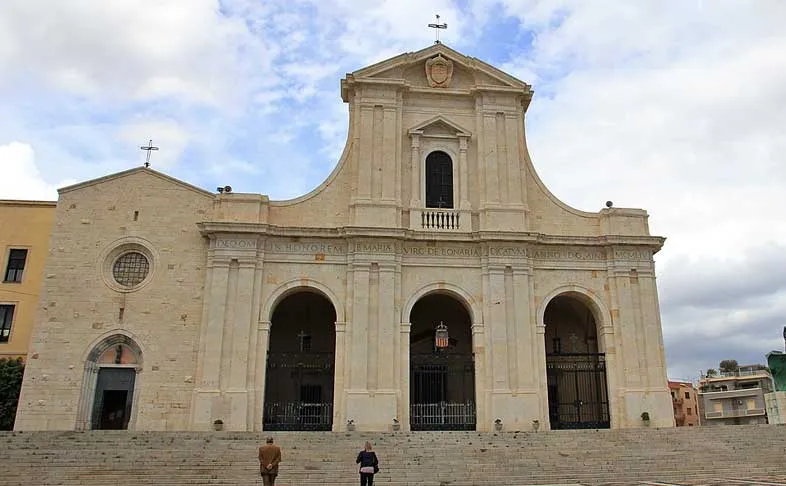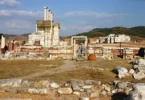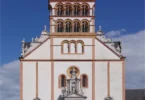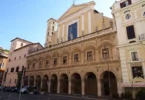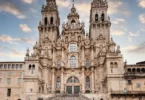
Introduction
The Shrine of Our Lady of Bonaria also known as Our Lady of Fair Winds is a Marian title associated with the Blessed Virgin Mary as Star of the Sea and patron of sailboats. In addition, it is first associated with a Roman Catholic shrine to the Blessed Virgin Mary located in Cagliari, Sardinia (Italy).
The Shrine is part of a complex of buildings which include the Basilica of Our Lady of Bonaria, the Sanctuary of Our Lady of Bonaria and the monastery which houses the friars of the Order of the Blessed Virgin Mary of Mercy. The Basilica and the other structures are under the administration of the Mercedarians, a religious order which has over seen the care of the shrine continuously since October 17, 1335.
Mary under this Marian title, is often portrayed carrying the Child Jesus, along with a golden sailboat and a candle in her right arm is invoked as the Patroness of Sardinia as well as Buenos Aires, Argentina, to which Pope Francis is also a known devotee.
The sanctuary of Nostra Signora di Bonaria (Sanctuary of Our Lady of Bonaria) is a religious complex in the city of Cagliari located on top of the homonymous hill.
It is one of the most important Marian buildings in Sardinia and consists of:
- From the Gothic-Catalan style sanctuary dating back to the first half of the 14th century; here is kept the simulacrum of “Our Lady of Bonaria” (or “Madonna di Bonaria”), the title given to the Madonna, as the highest patroness of Sardinia and Cagliari, protector of sailors.
- From the basilica dating back to the eighteenth century, in neoclassical style first elevated to a minor basilica by Pius XI in 1926, then to a real basilica in 1952 by Pope Pius XII;
- From the cemetery-monumental park of the same name;
- From the convent of the same name managed by the Order of the Mercedarian fathers, who also officiate religious functions as a parish seat. In the cloister there is also the Museum of Bonaria.
History of Sanctuary of Our Lady of Bonaria, Cagliari
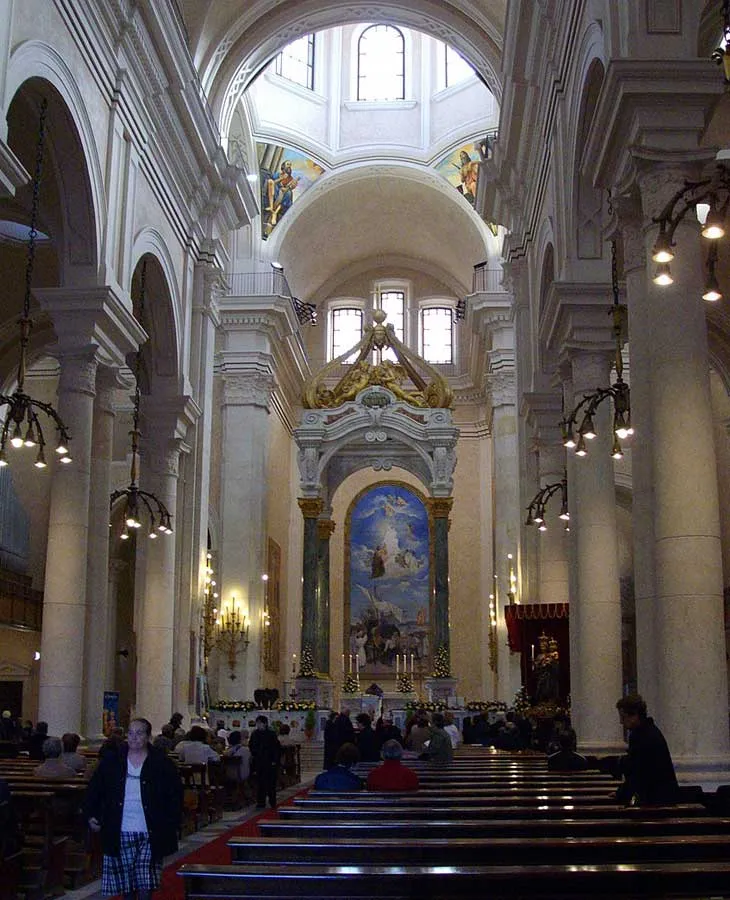
The sanctuary is the oldest part of the complex and was the first example of Catalan-Gothic architecture in Sardinia. In 1324, during the siege of Castel di Castro, the infante Alfonso had a fortified citadel built on this hill, known in Catalan as Bon Aire or “good air”. In 1326 Pisa abandoned Sardinia forever and, in 1335, the king donated the area of Bonaria to the friars of the Order of Santa Maria della Mercede, at the time in its maximum splendour, who had a convent built there with the adjoining church, style Catalan-Aragonese.
The construction of the basilica, which flanks the sanctuary, dates back to 1704, when the mercedarian friars decided to build a larger church in honor of the Virgin of Bonaria. The church, built to a design by the Piedmontese architect Antonio Felice De Vincenti, was originally designed in the Baroque style; however, the works suffered interruptions, and towards the end of the 18th century they were entrusted to the architect Giuseppe Viana, who reworked the project in a neoclassical style.
During the 19th century the works suffered several slowdowns. On 24 April 1885 the archbishop of Cagliari Paolo Maria Serci Serra reconsecrated the sanctuary after some works had been carried out; a large plaque was placed in memory of the double event. However, the building was only completed in 1926, the year in which Pope Pius XI gave it the title of minor basilica.
During the Second World War the building suffered serious damage due to bombing; it was renovated between 1947 and 1960 and then again in 1998.
The shrine of Bonaria was visited on 24 April 1970 by Pope Paul VI, by Pope John Paul II on 20 October 1985, by Pope Benedict XVI on 7 September 2008 during his visit to Cagliari and by Pope Francis on 22 September 2013, for underline the link between the cities of Cagliari and Buenos Aires, given that the capital of Argentina takes its name from this shrine.
History of the Statue of Our Lady of Bonaria
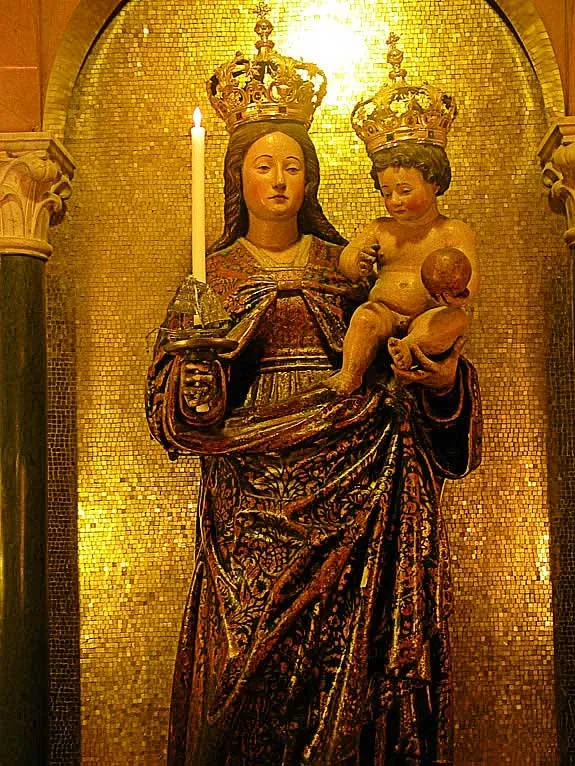
According to legend, on March 25, 1370, a ship leaving Catalonia was caught in a storm. The sailors then decided to throw all the cargo overboard, including a heavy crate. As soon as the crate was thrown into the sea, the storm subsided.
The case then landed in Cagliari, just below the hill of Bonaria; the friars of the convent, having opened it, found a carob wood statue of the Virgin Mary who holds the Child Jesus in one hand and in the other has a lit candle Santa Maria della Candelora. Devotion to the miraculous statue immediately spread throughout Sardinia, especially among the sailors who invoked it as a protector.
In fact, the legend always tells that the ivory boat, offered in thanksgiving to the Virgin by a devotee, which had been hung in front of the statue with a hemp rope, had begun to move, marking the winds that blew outside the gulf of Cagliari and that sailors, before setting out to sea, always went to the sanctuary.
The Spanish conquistadors devoutly gave his name to the capital of Argentina, Buenos Aires. On 13 September 1907, Pope Pius X proclaimed Our Lady of Bonaria as the highest patroness of Sardinia.
One hundred years later, in 2007, the centenary of this proclamation was celebrated, which ended on 7 September 2008 with a solemn celebration presided over by Pope Benedict XVI, who came on a pastoral visit to Cagliari (the official announcement of the event was given to Sardinia whole by the archbishop of Cagliari Giuseppe Mani in the mass of the Nativity in the cathedral, on December 25, 2007).
The visit to Cagliari was the third and last apostolic journey to Italy for 2008, after Liguria and Puglia. On 22 September 2013, Pope Francis visited the sanctuary of the Madonna di Bonaria for his first pastoral visit.
The Sanctuary

The fourteenth-century sanctuary was extensively remodeled in the fifties of the twentieth century, in order to bring it back to its original form. The facade, aligned with that of the basilica, is very simple, gabled. To access the church, you enter through the portal, in Gothic style, which was recovered from the medieval church of San Francesco in Stampace, which was demolished in the 19th century.
The interior, still in Catalan-Gothic style, has a single nave with an ogival vault. On the left side there are three chapels, also in Gothic style, with cross vaults, while on the right side there is the arch that connects the sanctuary to the basilica (the four chapels that opened on this side were demolished following the works of construction of the basilica).
At the back of the hall, raised above the floor, is the presbytery which ends with the polygonal apse where the main altar is; this is the heart of the sanctuary, because the imposing fourteenth-century wooden statue of the Madonna and Child, known as Our Lady of Bonaria, is enthroned on the altar. Thus finding himself at the height of the feet of the statue.
At the base of the balustrade, on either side of the access stairway to the presbytery, there are the tombs of Domenico Alberto Azuni (left) and that of the servant of God Fra’ Antonino Pisano (right), mercedarian friar of Cagliari, who died in 1927. In the grandstand there is an organ (1886), built by Carlo Aletti from Monza.
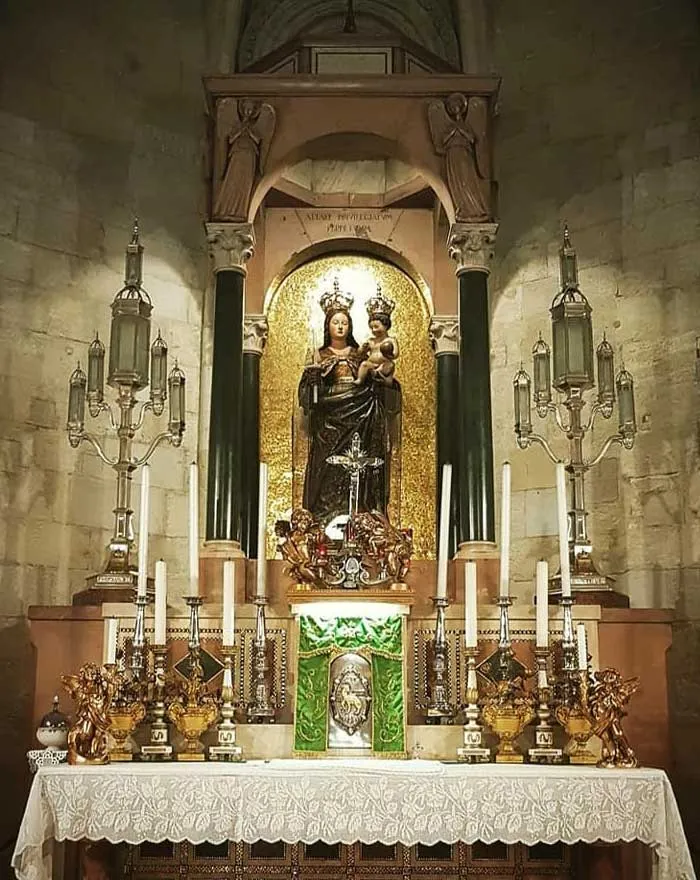
The Suspended Spacecraft
Over the centuries, numerous votive objects have been donated to the sanctuary of Bonaria which in ancient times were hung on the side walls. Among these is a small statue depicting an ivory boat, about 30 cm long which is located in the architrave immediately before the apse where the statue of the Virgin is located. This object is one of the oldest that the sanctuary can boast.
According to legend, the ship was donated in the 15th century by one of the many pilgrims who went to the sanctuary to venerate the statue. The pilgrim, whose identity is unknown, initially thought of allocating the ex voto to the Holy Land but, being struck by the history of the sanctuary, she decided to donate the ship to the Madonna of Bonaria.
This was hung with a cord, suspended above the apse, and was immediately a pilgrimage destination for the fishermen of the area, and has remained there: in fact, it is said that this object indicates the direction of the currents that blow in the Gulf of Cagliari. For this reason, Cagliari fishermen, before venturing into the open sea, went to the sanctuary to ask for information and the boat moved and with the bow indicated the direction of the wind.

The Basilica - External
The facade of the basilica is presented in a simple neoclassical style, dating back to the period 1704 – 1730, and also built thanks to the contribution of the Mercedarian Order. It is made up of white limestone with a large portico, above which, in correspondence with the central nave, there is a tympanum that encloses the coat of arms of the Order of Mercede and, further down, dominated by another tympanum and framed by small columns classical, the loggia of blessings opens.
The facade was renovated around 1958 by the Perugian architect Gina Baldracchini. In the entrance hall, on the left, there is a sculpture by the Milanese Enrico Manfrini depicting Pope Paul VI, who visited the sanctuary of Bonaria in 1970. The side portals in bronze, dating back to the 1985 – 1990 renovation period, depict winged figures supporting the coat of arms of Cagliari and were created by the sculptor Ernesto Lamagna.
The main door however, was restored with new 24 panels by Stefania Ariu in 2016, on the occasion of the centenary of the Mercedarian Order (2018). In the churchyard, there are also two sculptures by Franco D’Aspro. To reach the top of the complex, in the 1930s the Municipality of Cagliari intended to build a white stone stairway, starting from the underlying viale Armando Diaz. However the works were postponed due to the Second World War, so the staircase was built between 1962 and 1967.
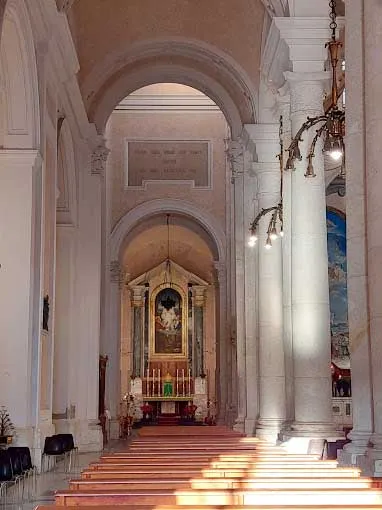
Interior
The vast and bright interior has a Latin cross plan, divided into three naves, with a large transept surmounted by a high octagonal dome (50 metres). The aisles are separated by four arches, resting on paired columns in white limestone. The central nave, 54 meters long, has a barrel vault cover, while the side naves are respectively covered by four small domes.
The main altar is surmounted by a canopy supported by four green marble columns decorated with gilt copper figures of angels, as are the capitals and arches. In front of the presbytery, at the height of the last couple of columns on the right, there is a reproduction of the statue of the Madonna di Bonaria.
In the lateral aisles there are the chapels, four on the right and three on the left, in which there are large canvases depicting the Madonna, dating back to the fifties of the twentieth century. The canvases depicting Mary Help of Christians (first chapel on the right), the Assumption (second chapel on the right), Our Lady of Fátima (fourth chapel on the right), Our Lady of the Rosary (first chapel on the left), the Immaculate Virgin (third chapel on the left) are the work of Antonio Mura.
In the third chapel of the right aisle, there is the painting of the Holy Family by Giuseppe Aprea, while the second chapel of the left aisle contains the canvas depicting the Madonna della Mercede, a work by Gina Baldracchini dating back to 1961.
The transept houses the statue of the Madonna del Combattente, by Francesco Ciusa, created between 1936 and 1938. Also in the transept there are two chapels in their respective arms, in the right one the chapel of the Madonna della Vittoria or dei Caduti, built in 1930 at the request of the mothers of the war dead, adorned with a marble altar in Baroque style with a bas-relief depicting the Pietà, in the left arm the chapel of the Blessed Sacrament, in which there is another canvas by Antonio Mura, depicting the Supper at Emmaus.

Pipe Organ
In the transept of the church, on two choir lofts, there is the Tamburini pipe organ opus 438, built in 1961. The instrument, with electric transmission, has three keyboards of 61 notes each and a concave-radial pedal board of 32.
The Museum
In the cloister of the convent is the Museum of the sanctuary, which preserves archaeological evidence, naval models, sacred furnishings and votive offerings. After the restoration work in the fifties, the sanctuary building was brought back to its original architectural lines, to the purest Catalan-Gothic style; it was therefore necessary to remove all the previous overlaps.
Even the votive offerings that were kept there were all removed and placed as best they could in some rooms, waiting for a definitive arrangement. In 1968, the rector Father Pasquale Pasquariello created a small museum, intended to conserve and preserve the ex-votos from destruction; this museum was inaugurated in July 1968, on the occasion of the Bonaria summer festival.
Queen Patroness
Devotion to Our Lady of Bonaria spread quickly over the island, and the Blessed Virgin Mary under this title has been named the patroness of Sardinia, then later became a patroness for Buenos Aires, Argentina along with the Holy Trinity.
Canonical Coronation and Honours
The Basilica of Our Lady of Bonaria was visited by Pope Benedict XVI on Feast of the Nativity of Mary in 2008. On that solemn occasion, the Pontiff granted a canonical coronation to the famed image, and bestowed the honor of a Golden Rose on the shrine.
Pope Francis made a repeated Apostolic visit to Sardinia in September 2013.
Feast Day – 24th April
Annual Feast Day of Our Lady of Bonaria (Nostra Signora di Bonaria) is celebrated on 24th April.
Mass Time
Weekdays
Sundays
Church Visiting Time
Contact Info
Sanctuary of Our Lady of Bonaria,
2, Piazza Bonaria, 09125,
Cagliari CA, Sardinia, Italy.
Phone No.
Tel : +39 070 301747
Accommodations
How to reach the Sanctuary
Cagliari Elmas Airport is an international airport located in the territory of Elmas, near Cagliari, Island of Sardinia, Italy is the nearby Airport to the Sanctuary.
Cagliari Transit Station in Cagliari, Island of Sardinia, Italy is the nearby Train Station to the Sanctuary.

